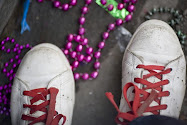







We landed in Port-au-Prince just as the sun was rising . After getting our bearings and loading the gear onto a truck, we waited for transportation. Waiting is a sub-theme in most things millitary. Along the edges of the runway were pallets loaded with supplies. Civilians from different aid organizations were also waiting around. There was a sea of water bottles, everything from Aquafina to Fiji . Boarding small tourist busses from the Dominican Republic that had a tropical flair, we made our way to a camp known as APOD - Arial Point of Debarkation. Once in our tent we set up cots. I was lent a mosquito net which transformed my cot into a canopy bed of sorts.
The camp is in a state of constant flux. We had to move twice before we had a tent we could call home. Search and rescue teams made the initial set up and left the tents behind in a deal struck by the 3d Sustainment Command Expeditionary. In return for the tent loan, the 3SCE will use their logistic capability to return them. A jumbo tent ( the fusion cell) went up the first day I arrived and was made internet ready. It will serve as the logistical hub for the entire theater. Incoming troops are coming faster than available space to house them is identified, yet everyone is being accommodated.
The tents that serve as living quarters are basic. Inside them it feels like an oven in the daytime. The cots are standard army issue. Mosquitos and spiders share the space. There are Porto-Johns and portable cold water showers with outdoor sinks nearby. There is no kitchen, only MREs for grub and lots of water; the millitary is big on keeping soldiers hydrated. Considering there was nothing here before the earthquake the camp is pretty great.
I accompanied Sgt. Tomas of the 7th Sustainment Brigade to the port and another camp. His driver, Fred, lives in Port-au-Prince and gave us a mini tour enroute. The damage breathtaking; the devastation is mind boggling. I was surprised to see signs of everyday life everywhere. We drove by a bustling outdoor market and the streets were full of traffic. Tent cities all around the city are a reminder that nothing will be normal for a long time to come.







Saturday, January 30, 2010
On the Ground in Haiti
Subscribe to:
Post Comments (Atom)




Great writing and reporting Julie.You tell the story in both words and pictures. I liked the sign that said no photography. I like signs that tell you what not to do. Years ago people in the back woods used to put up signs that read "No Hunting, No Fishing,No Nothing"
ReplyDeletethank you for your work, julie. it provides those of us with hearts attached to military service members deployed to haiti better insight as to the living conditions and work environment they function in. i respect and appreciate their service, as i do yours.
ReplyDelete